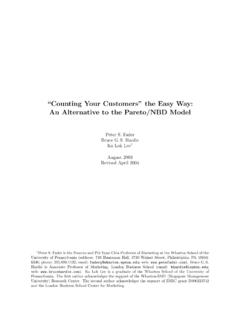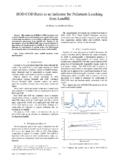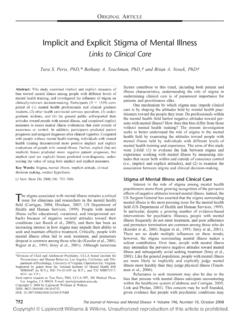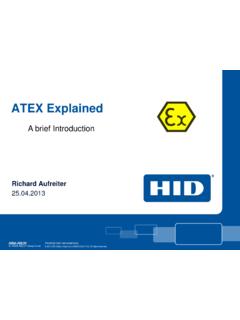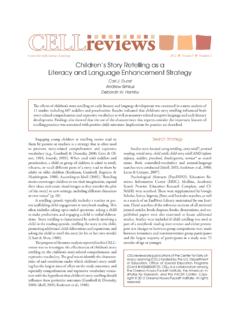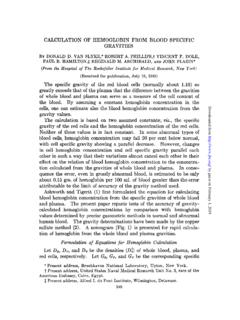Transcription of “Counting Your Customers” the Easy Way: An Alternative to ...
1 Vol. 24, No. 2, Spring 2005, pp. 275 284issn0732-2399 eissn1526-548X 05 2402 0275informs 2005 INFORMS counting your Customers the Easy Way:An Alternative to the Pareto/NBD ModelPeter S. FaderThe Wharton School, University of Pennsylvania, 749 Huntsman Hall, 3730 Walnut Street,Philadelphia, Pennsylvania 19104-6340, G. S. HardieLondon Business School, Regent s Park, London NW1 4SA, United Kingdom, Lok LeeCatalina Health Resource, Blue Bell, Pennsylvania 19422, s managers are very interested in predicting the future purchasing patterns of their customers, whichcan then serve as an input into lifetime value calculations.
2 Among the models that provide such capa-bilities, the Pareto/NBD counting your customers framework proposed by Schmittlein et al. (1987) is highlyregarded. However, despite the respect it has earned, it has proven to be a difficult model to implement, par-ticularly because of computational challenges associated with parameter develop a new model, the beta-geometric/NBD (BG/NBD), which represents a slight variation in thebehavioral story associated with the Pareto/NBD but is vastly easier to implement. We show, for instance,how its parameters can be obtained quite easily in Microsoft Excel.
3 The two models yield very similar resultsin a wide variety of purchasing environments, leading us to suggest that the BG/NBD could be viewed as anattractive Alternative to the Pareto/NBD in most words: customer base analysis; repeat buying; Pareto/NBD; probability models; forecasting; lifetime valueHistory: This paper was received August 11, 2003, and was with the authors 7 months for 2 revisions;processed by Gary IntroductionFaced with a database containing information onthe frequency and timing of transactions for a listof customers, it is natural to try to make fore-casts about future purchasing.
4 These projections oftenrange from aggregate sales trajectories ( , for thenext 52 weeks), to individual-level conditional expec-tations ( , the best guess about a particular cus-tomer s future purchasing, given information abouthis past behavior). Many other related issues mayarise from a customer -level database, but these aretypical of the questions that a manager should ini-tially try to address. This is particularly true for anyfirm with serious interest in tracking and managing customer lifetime value (CLV) on a systematic is a great deal of interest, among marketingpractitioners and academics alike, in developing mod-els to accomplish these of the first models to explicitly address theseissues is the Pareto/NBD counting your customers framework originally proposed by Schmittlein et al.
5 (1987), called hereafter SMC. This model describesrepeat-buying behavior in settings where customer dropout is unobserved: It assumes that customersbuy at a steady rate (albeit in a stochastic manner)for a period of time, and then become inactive. Morespecifically, time to dropout is modelled using thePareto (exponential-gamma mixture) timing model,and repeat-buying behavior while active is modelledusing the NBD (Poisson-gamma mixture) countingmodel. The Pareto/NBD is a powerful model forcustomer-base analysis, but its empirical applicationcan be challenging, especially in terms of because of these operational difficulties,relatively few researchers actively followed up on theSMC paper soon after it was published (as judged bycitation counts).
6 However, it has received a steadilyincreasing amount of attention in recent years asmany researchers and managers have become con-cerned about issues such as customer churn, attrition,retention, and CLV. While a number of researchers( , Balasubramanian et al. 1998, Jain and Singh2002, Mulhern 1999, Niraj et al. 2001) refer to theapplicability and usefulness of the Pareto/NBD, onlya small handful claim to have actually implementedit. Nevertheless, some of these papers ( , Reinartzand Kumar 2000, Schmittlein and Peterson 1994)have, in turn, become quite popular and widely et al.
7 : counting your Customers the Easy Way276 Marketing Science 24(2), pp. 275 284, 2005 INFORMSThe objective of this paper is to develop a newmodel, the beta-geometric/NBD (BG/NBD), whichrepresents a slight variation in the behavioral story that lies at the heart of SMC s original work, but isvastly easier to implement. We show, for instance,how its parameters can be obtained quite easilyin Microsoft Excel, with no appreciable loss in themodel s ability to fit or predict customer purchas-ing patterns. We develop the BG/NBD model fromfirst principles and present the expressions requiredfor making individual-level statements about futurebuying behavior.
8 We compare and contrast its perfor-mance to that of the Pareto/NBD via a simulation andan illustrative empirical application. The two modelsyield very similar results, leading us to suggest thatthe BG/NBD should be viewed as an attractive alter-native to the Pareto/NBD developing the BG/NBD model, we brieflyreview the Pareto/NBD model ( 2). In 3 we outlinethe assumptions of the BG/NBD model, deriving thekey expressions at the individual level and for a ran-domly chosen individual, in 4 and 5, is followed by the aforementioned simulationand empirical analysis.
9 We conclude with a discussionof several issues that arise from this The Pareto/NBD ModelThe Pareto/NBD model is based on five assumptions:(i) While active, the number of transactions madeby a customer in a time period of lengthtis dis-tributed Poisson with mean t.(ii) Heterogeneity in the transaction rate acrosscustomers follows a gamma distribution with shapeparameterrand scale parameter .(iii) Each customer has an unobserved lifetime oflength . This point at which the customer becomesinactive is distributed exponential with dropoutrate.
10 (iv) Heterogeneity in dropout rates across cus-tomers follows a gamma distribution with shapeparametersand scale parameter .(v) The transaction rate and the dropout rate vary independently across Pareto/NBD (and, as we will see shortly, theBG/NBD) requires only two pieces of informationabout each customer s past purchasing history: his recency (when his last transaction occurred) and frequency (how many transactions he made in aspecified time period). The notation used to representthis information is (X=x tx T), wherexis the num-ber of transactions observed in the time period 0 T andtx(0<tx T) is the time of the last these two key summary statistics, SMC deriveexpressions for a number of managerially relevantquantities, such as: E X t , the expected number of transactions in atime period of lengtht(SMC, Equation (17)), which iscentral to computing the expected transaction volumefor the whole customer base over time.

